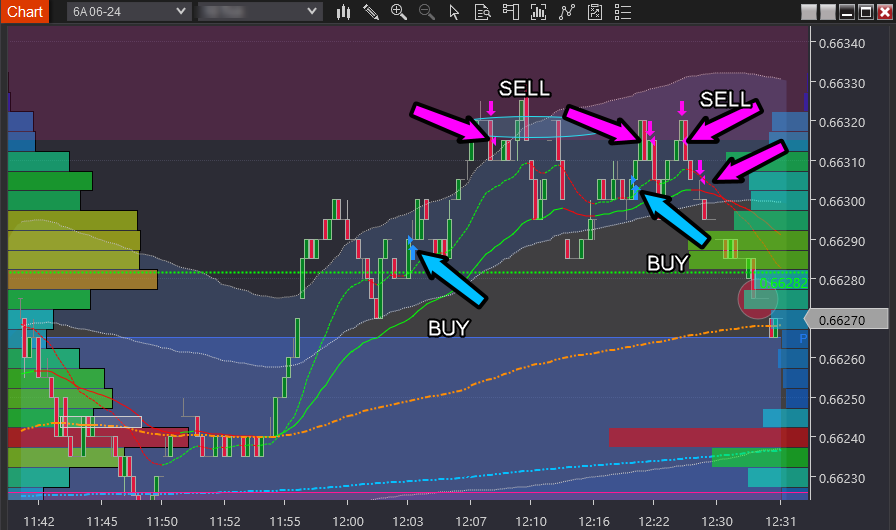The arch-nemesis of the directional trader?
Efficiency. Periods when all known information is reflected in the price. It's unlikely price will move meaningfully to profit from.
The trouble is, without an awareness of when market efficiency falters, most traders are firing shots in the dark, hoping to catch these lucrative trades.
However, their shots are aimless. Catching a 'one-way traffic' trade is mostly a matter of luck and doesn't compensate for the losses incurred for missing. Hence the saying, "You win some—you lose more."
Instead, you're looking for the rare occasion when market efficiency breaks—resembling a broken ATM spitting out a continuous stream of 100-dollar bills to those who know what to look for—a frenzy of aggressive buying or selling activity that dominates the market. Described as a 'strong move', price is 'one-way traffic' only.
But here's the kicker
Market opportunities frequently resemble the deceptive tactics of chess. Often, the winner purposely disguises the outcome (checkmate) by allowing the opponent 'small victories'—taking a bishop, knight, pawns, or rook (castle)—on the journey to their ultimate demise.
Like chess, the element of surprise is the catalyst for the outcome—checkmate in chess, broken ATM in trading.
I refer to the period leading up to the broken ATM trade erupting as 'before the outcome is known'.
It's a critical part of your strategy because if you wait until the outcome has taken place, you'll miss out. Make sense?
It requires knowing the deceptive moves and which market participants will fall for them. As Michael Marcus, who turned 30K into 80M, said, "Successful trading is anticipating the anticipations of others."
Once you're aware deceptive tactics have ensnared enough competitors to fuel the broken ATM trade, the next challenge is knowing the exact timing of the trade erupting.
It's a challenge because you're not pulling the strings; you'll ride along on the coattails.
Take Monday
The first attempts to enter a trade to erupt to the upside were in vain. You can see the buy entries and subsequent exits in the chart below.
What happens next?
They highlight the need for precision and timing skills. The reason to exit is not a 'gut feel'; it's market evidence-driven. But without these skills, trades are entered only to quash hopes and dreams as the price moves further and further against you until you're facing an outsized loss. Sound familiar?
What do you know about it being by design?
If too many of us try to ride the coattails, the market will flush many out. Why? Because this business is about the majority paying the minority. Like poker, there's no such thing as an even distribution of winnings in trading. Correct?
Shortly after the above trades, the market moved significantly lower, and hangers-on were washed out of the market for a loss.
One of the 'easiest' trading edges is outlasting the competition. But it's only accessible if you know how the game works. If not, you fall victim to what I refer to as the 'time-trap'.
The broken ATM trades occurred hours later. The last of which was 6 hours after the initial trade above.
The reason for showing one of the trades is to illustrate how the price was one-way traffic, an example of when trading takes on the appearance of seeming effortless.
Notice in both charts the buying was in the same pricing area?
If held, the first attempt would have resulted in an epic fail (and loss), while the second time was successful. As mentioned, this is by design.
Why else do broken ATM trades transform your trading?
I've already touched on it: Winnings aren't evenly distributed—the majority pay for the few to win.
When you shift your focus to broken ATM trades, you join the prosperous few and remove yourself from the majority who are net losers.
It's a powerful reason to focus on inefficiency in the market. Agree?
Forex and derivatives trading is a highly competitive and often extremely fast-paced environment. It only rewards individuals who attain the required level of skill and expertise to compete. Past performance is not indicative of future results. There is a substantial risk of loss to unskilled and inexperienced players. The high degree of leverage can work against you as well as for you. Before deciding to trade any such leveraged products you should carefully consider your investment objectives, level of experience, and risk appetite. The possibility exists that you could sustain a loss of some or all of your initial investment and therefore you should not invest money that you cannot afford to lose. You should be aware of all the risks associated with trading on margin, and seek advice from an independent
Editors’ Picks

AUD/USD struggles to reconquer the 0.6700 mark
The AUD/USD pair trades just below 0.6700 in the Asian session on Tuesday, trying to regain some ground after falling at the beginning of the week. The US Dollar benefited from a dismal mood, with a sell-off in tech shares leading an otherwise slow session.

USD/JPY stalls as Yentervention risk weighs
USD/JPY reversed course to open the final week of the trading year, falling back to the 156.00 region and paring off last week’s late burst of bullish momentum. General volatility is expected to widen during the last trading week of 2025, and follow into early 2026 as holiday-thinned market volumes wreak havoc on general market trends.

Gold holds above $4,300 after setting yet another record high
Spot Gold traded as high as $4,550 a troy ounce on Monday, fueled by persistent US Dollar weakness and a dismal mood. The XAU/USD pair was hit sharply by profit-taking during US trading hours and retreated towards $4,300, where buyers reappeared.

Ethereum: BitMine continues accumulation, begins staking ETH holdings
Ethereum treasury firm BitMine Immersion continued its ETH buying spree despite the seasonal holiday market slowdown. The company acquired 44,463 ETH last week, pushing its total holdings to 4.11 million ETH or 3.41% of Ethereum's circulating supply, according to a statement on Monday. That figure is over 50% lower than the amount it purchased the previous week.

Bitcoin Price Annual Forecast: BTC holds long-term bullish structure heading into 2026
Bitcoin (BTC) is wrapping up 2025 as one of its most eventful years, defined by unprecedented institutional participation, major regulatory developments, and extreme price volatility.
RECOMMENDED LESSONS
Making money in forex is easy if you know how the bankers trade!
I’m often mystified in my educational forex articles why so many traders struggle to make consistent money out of forex trading. The answer has more to do with what they don’t know than what they do know. After working in investment banks for 20 years many of which were as a Chief trader its second knowledge how to extract cash out of the market.
5 Forex News Events You Need To Know
In the fast moving world of currency markets where huge moves can seemingly come from nowhere, it is extremely important for new traders to learn about the various economic indicators and forex news events and releases that shape the markets. Indeed, quickly getting a handle on which data to look out for, what it means, and how to trade it can see new traders quickly become far more profitable and sets up the road to long term success.
Top 10 Chart Patterns Every Trader Should Know
Chart patterns are one of the most effective trading tools for a trader. They are pure price-action, and form on the basis of underlying buying and selling pressure. Chart patterns have a proven track-record, and traders use them to identify continuation or reversal signals, to open positions and identify price targets.
7 Ways to Avoid Forex Scams
The forex industry is recently seeing more and more scams. Here are 7 ways to avoid losing your money in such scams: Forex scams are becoming frequent. Michael Greenberg reports on luxurious expenses, including a submarine bought from the money taken from forex traders. Here’s another report of a forex fraud. So, how can we avoid falling in such forex scams?
What Are the 10 Fatal Mistakes Traders Make
Trading is exciting. Trading is hard. Trading is extremely hard. Some say that it takes more than 10,000 hours to master. Others believe that trading is the way to quick riches. They might be both wrong. What is important to know that no matter how experienced you are, mistakes will be part of the trading process.
The challenge: Timing the market and trader psychology
Successful trading often comes down to timing – entering and exiting trades at the right moments. Yet timing the market is notoriously difficult, largely because human psychology can derail even the best plans. Two powerful emotions in particular – fear and greed – tend to drive trading decisions off course.



